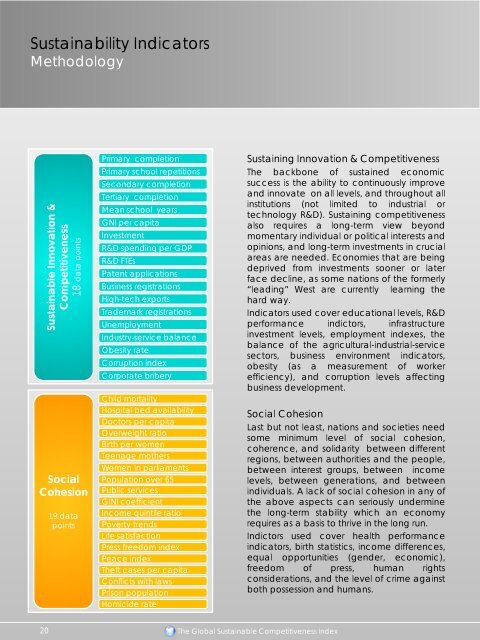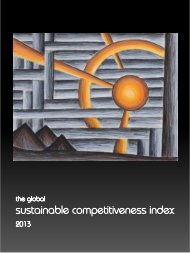Global Competetiveness Report
You also want an ePaper? Increase the reach of your titles
YUMPU automatically turns print PDFs into web optimized ePapers that Google loves.
Sustainability Indicators<br />
Methodology<br />
Sustainable Innovation &<br />
Competitiveness<br />
18 data points<br />
Social<br />
Cohesion<br />
19 data<br />
points<br />
Primary completion<br />
Primary school repetitions<br />
Secondary completion<br />
Tertiary completion<br />
Mean school years<br />
GNI per capita<br />
Investment<br />
R&D spending per GDP<br />
R&D FTEs<br />
Patent applications<br />
Business registrations<br />
High-tech exports<br />
Trademark registrations<br />
Unemployment<br />
Industry-service balance<br />
Obesity rate<br />
Corruption index<br />
Corporate bribery<br />
Child mortality<br />
Hospital bed availability<br />
Doctors per capita<br />
Overweight ratio<br />
Birth per women<br />
Teenage mothers<br />
Women in parliaments<br />
Population over 65<br />
Public services<br />
GINI coefficient<br />
Income quintile ratio<br />
Poverty trends<br />
Life satisfaction<br />
Press freedom index<br />
Peace index<br />
Theft cases per capita<br />
Conflicts with laws<br />
Prison population<br />
Homicide rate<br />
Sustaining Innovation & Competitiveness<br />
The backbone of sustained economic<br />
success is the ability to continuously improve<br />
and innovate on all levels, and throughout all<br />
institutions (not limited to industrial or<br />
technology R&D). Sustaining competitiveness<br />
also requires a long-term view beyond<br />
momentary individual or political interests and<br />
opinions, and long-term investments in crucial<br />
areas are needed. Economies that are being<br />
deprived from investments sooner or later<br />
face decline, as some nations of the formerly<br />
“leading” West are currently learning the<br />
hard way.<br />
Indicators used cover educational levels, R&D<br />
performance indictors, infrastructure<br />
investment levels, employment indexes, the<br />
balance of the agricultural-industrial-service<br />
sectors, business environment indicators,<br />
obesity (as a measurement of worker<br />
efficiency), and corruption levels affecting<br />
business development.<br />
Social Cohesion<br />
Last but not least, nations and societies need<br />
some minimum level of social cohesion,<br />
coherence, and solidarity between different<br />
regions, between authorities and the people,<br />
between interest groups, between income<br />
levels, between generations, and between<br />
individuals. A lack of social cohesion in any of<br />
the above aspects can seriously undermine<br />
the long-term stability which an economy<br />
requires as a basis to thrive in the long run.<br />
Indictors used cover health performance<br />
indicators, birth statistics, income differences,<br />
equal opportunities (gender, economic),<br />
freedom of press, human rights<br />
considerations, and the level of crime against<br />
both possession and humans.<br />
20<br />
The <strong>Global</strong> Sustainable Competitiveness Index








